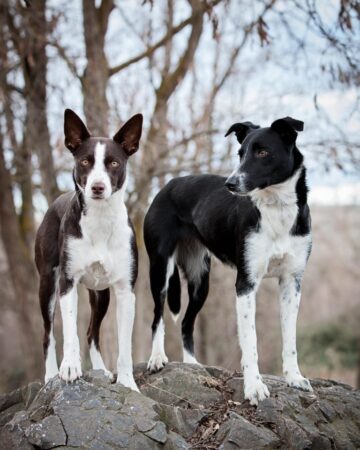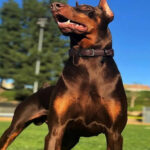The McNab Dog is a relatively uncommon but highly versatile breed that has gained popularity in recent years. Originally bred for herding and ranch work, these dogs have a unique combination of intelligence, athleticism, and loyalty that make them an excellent choice for active owners and families. Before considering adopting a McNab Dog, it is important to understand their origins, personality, and specific care requirements. In this article, we will cover all the essential information you need to know about the McNab Dog, from their history and characteristics to their health and training needs. Whether you are a seasoned dog owner or considering getting your first pet, this comprehensive guide will provide you with all the information you need to make an informed decision about whether the McNab Dog is the right breed for you.
The McNab Dog: All You Need to Know Before You Adopt One
The McNab Dog, also known as the McNab Shepherd or McNab Sheepdog, is a working breed that originated in Mendocino County, California in the late 19th century. They were developed by Alexander McNab, a Scottish immigrant who wanted to create a herding dog that could handle the rugged terrain and climate of the area.
Height:
The McNab Dog is a medium-sized breed, standing between 18-25 inches (46-64 cm) at the shoulder for males and 17-22 inches (43-56 cm) for females.
Weight:
On average, McNab Dogs weigh between 40-65 pounds (18-29 kg).
Lifespan:
The average lifespan for a McNab Dog is 12-15 years.
Colors:
The McNab Dog comes in a variety of colors, including black, red, blue, brown, and red merle. They may also have white markings on their chest, face, and feet.
Temperament:
McNab Dogs are known for their intelligence, athleticism, and high energy levels. They are highly trainable and excel at tasks such as herding, agility, and obedience. They are also loyal and protective of their families, making them good watchdogs. However, they may be reserved or wary around strangers and require early socialization and training to prevent aggression or shyness.
Grooming:
The McNab Dog has a short, smooth coat that is easy to maintain. They only require occasional brushing to remove dead hair and keep their coat shiny and healthy.
Exercise:
This breed is highly active and requires daily exercise to meet their energy needs. They thrive in homes with large yards where they can run and play. They also make good running or hiking companions.
Training:
McNab Dogs are intelligent and eager to please, making them relatively easy to train. However, they may have a strong herding instinct and may need additional training to curb this behavior. Positive reinforcement methods work best with this breed.
McNab Dog vs Border Collie
The McNab Dog and the Border Collie are both herding breeds that are known for their intelligence, energy, and trainability. However, they have some key differences in terms of appearance and temperament. McNab dogs are typically black and white, or tricolor, while Border Collies can come in a variety of colors and patterns. McNabs also tend to be more muscular and stocky than Border Collies. In terms of temperament, McNabs are known for being more independent and less affectionate than Border Collies. They are also less vocal and more calm around strangers.
McNab Border Collie Mix Dog
A McNab Border Collie Mix, or a “McNollie,” is a hybrid dog that combines the traits of both the McNab and the Border Collie. They are typically highly intelligent, energetic, and trainable dogs that excel at herding and other activities that require focus and stamina. They are also known for being friendly and affectionate with their families, though they may be wary of strangers. McNollies usually have a black and white coat of the McNab, with the possible addition of brown or red patches.
McNab Puppies for Sale Near Me
While we cannot guarantee the availability of specific breeds at any given time, here are a few places to start your search for McNab puppies for sale near you:
- Local McNab Breeder: The best place to start your search for a McNab puppy is with a local breeder. They will have the most knowledge about the breed and can provide you with information on the health and background of the puppies. You can find local breeders through a quick online search or by checking with your local dog club or association.
- Online Marketplaces: Websites such as PuppyFinder, NextDayPets, and Greenfield Puppies often have listings for McNab puppies for sale from reputable breeders. These sites allow you to search for puppies by location, breed, and price. Just make sure to do your research on the seller and ask for health and genetic testing information before making a purchase.
- Rescue Organizations: Consider adopting a McNab puppy from a rescue organization. While they may not always have purebred McNab puppies available, they often have mixes that need a good home. This is also a great option for those looking to give a loving home to a dog in need.
History of The McNab Dog
The McNab Dog breed originated in the late 19th century in the Mendocino County region of Northern California. The breed was named after its founder, Scottish immigrant Alexander McNab, who was a rancher and sheepherder in the region.
Alexander McNab began breeding dogs in the late 1800s, using a mix of Scottish Border Collies, Irish and Scottish Shepherds, and Native American dogs. He was known for his skill as a sheepherder and for his exceptional dogs, which were bred for their intelligence, athleticism, and herding abilities.
McNab’s dogs quickly gained a reputation for their abilities and were in high demand by local ranchers and sheepherders. The McNab Dog became an integral part of the sheepherding culture in Northern California and was used to herd livestock on the steep and rugged terrain of the region.
As the breed became more popular, McNab established strict breeding standards and kept meticulous records of his dogs’ pedigrees. He also began to sell his dogs to neighboring ranchers, further spreading the popularity of the breed.
In the 1930s, the breed was recognized by the American Kennel Club (AKC) as the “California Shepherd” but was not officially recognized as a breed until 2018 when the AKC officially recognized the McNab Dog.
Today, the McNab Dog is still used as a working dog on ranches and farms, but also makes a great companion for active and outdoorsy families. They excel in dog sports, such as agility and competitive herding trials, and are highly prized for their intelligence, endurance, and loyalty.
Characteristics of The McNab Dog
- High Energy: The McNab dog breed is known for its high energy levels and need for exercise. They were bred to be working dogs, so they have a lot of stamina and require daily physical activity to keep them mentally and physically stimulated.
- Intelligent: These dogs are highly intelligent and are quick learners. They were bred to be problem solvers and have a strong work ethic, which makes them excellent at tasks such as herding and agility training.
- Independent: McNabs are independent thinkers and may not always follow commands blindly. They have a strong sense of self and may challenge authority if they feel it is necessary. Early socialization and training can help establish boundaries and build a strong bond with their owners.
- Athletic: These dogs are built for endurance and agility. They have a lean, athletic build with strong muscles, making them well-suited for tasks such as herding and agility competitions.
- Protective: McNabs have a strong protective instinct and will do anything to keep their family safe. They are alert and make excellent watchdogs, but can also be wary of strangers if not properly socialized.
- Not for First-Time Dog Owners: Due to their high energy levels, independent nature, and strong instincts, McNabs are not recommended for first-time dog owners. They require an experienced handler who can provide them with the stimulation and training they need to thrive.
- Good with Children: While McNabs may be wary of strangers, they are known to be great with children. They are gentle and patient, making them an ideal family pet.
- Low Maintenance Grooming: These dogs have a short, weather-resistant coat that requires minimal grooming. They may shed seasonally, but regular brushing can help keep the shedding under control.
- Health Concerns: Like all dog breeds, McNabs can be prone to certain health issues, including hip dysplasia, eye problems, and allergies. It is important to research and choose a reputable breeder to minimize the risk of these health concerns.
- Working Dogs: McNabs were bred to be working dogs and thrive in environments where they have a job to do. They may become destructive or develop behavioral issues if not given proper mental and physical stimulation. Without a job or task to focus on, these dogs can become bored and unhappy.
SEE ALSO: Vizsla Dog Breed Profile
Appearance of The McNab Dog
The McNab dog, sometimes called the McNab Shepherd, is a medium-sized working dog that was originally bred in California for herding cattle and sheep. They are typically tricolor dogs, with black, white, and tan fur. They have a short, smooth coat that is easy to groom, and they are known for being very athletic and muscular. McNabs usually have large, erect ears, and their tails are usually docked. They are also known for having a “foxy” face, with a pointed muzzle and a slightly wedge-shaped head.
Temperament of The McNab Dog
The McNab dog is known for being a loyal and hard-working breed. They are intelligent and have a strong work ethic, which makes them excellent herding dogs. McNabs are also known for being highly trainable and obedient, and they respond well to positive reinforcement and consistent training. They are often described as “alert” and “watchful,” and they make excellent guard dogs. However, they are also affectionate and loving with their families, and they enjoy spending time with their owners. McNabs tend to be aloof around strangers, but they are not aggressive.
Cost of The McNab Dog
The McNab Dog is a highly sought-after breed of herding dog, known for its intelligence, agility, and workaholic nature. The cost of a McNab Dog can vary depending on factors such as the breeder’s reputation, location, and the dog’s bloodline. On average, a McNab Dog can cost anywhere from $500 to $1,500. However, prices can go up to $2,500 or more for puppies from top-quality breeders.
Additionally, there may be additional costs associated with owning a McNab Dog, such as initial veterinary check-ups, vaccinations, food, bedding, and training. It is important to consider these costs in addition to the initial purchase price of the dog. It is also recommended to budget for potential future expenses, such as potential health issues or unexpected vet bills.
Health Conditions of The McNab Dog
- Hip Dysplasia: Hip dysplasia is a common condition in McNab dogs that can cause pain or discomfort in their hips. This is a genetic condition where the hip joint doesn’t develop properly, resulting in the bones rubbing against each other instead of fitting smoothly.
- Eye Problems: McNab dogs can suffer from various eye problems, including cataracts, progressive retinal atrophy, and corneal dystrophy. These conditions can lead to vision loss and should be regularly checked by a veterinarian.
- Trapped Neutrophil Syndrome: This is a hereditary condition in which the bone marrow doesn’t produce enough neutrophils, a type of white blood cell that helps fight infections. Dogs with this condition may have recurrent infections and a weakened immune system.
- Epilepsy: Epilepsy is a neurological disorder that can cause seizures and other symptoms. Some McNab dogs may be genetically predisposed to this condition, and it can be managed with medication.
- Allergies: Like any other dog breed, McNabs can also suffer from allergies. These can be triggered by food, pollen, or other environmental factors, and can cause skin irritation, itching, and rashes.
- Hypothyroidism: Hypothyroidism is a condition in which the thyroid gland doesn’t produce enough hormones, leading to a slower metabolism and other symptoms such as weight gain, lethargy, and skin issues.
- Bloat: Bloat, also known as gastric dilatation-volvulus is a life-threatening condition where the stomach fills with gas and rotates, cutting off blood flow. This is more common in large, deep-chested dogs like the McNab, and can be fatal if not treated immediately.
- Dental issues: McNab dogs are prone to dental issues such as periodontal disease, tooth decay, and tartar buildup. These can lead to bad breath, pain, and difficulty eating if not addressed.
How to Care for The McNab Dog
- Exercise: The McNab dog is an energetic breed that requires regular exercise to stay happy and healthy. Make sure to take your McNab for daily walks or runs, and provide them with plenty of opportunities to play and explore. Without enough exercise, the McNab may become destructive or develop behavioral issues.
- Mental Stimulation: In addition to physical exercise, the McNab dog also needs mental stimulation to stay mentally sharp. This can include training sessions, interactive toys, and games that challenge their intelligence. Without enough mental stimulation, the McNab may become bored and exhibit destructive behaviors.
- Proper Diet: Feeding your McNab a balanced and high-quality diet is essential for their overall health and well-being. Make sure to follow the recommended feeding guidelines for your dog’s age and activity level. Consult your veterinarian for advice on choosing the best diet for your McNab.
- Grooming: The McNab has a short and dense coat that is easy to maintain. They only require brushing once a week to remove any dead hair and distribute natural oils throughout their coat. They may need more frequent brushing during shedding season. It’s also important to regularly check their ears and trim their nails as needed.
- Socialization: The McNab is a highly social breed and thrives on the companionship of their family. They may become anxious or develop behavioral issues if left alone for long periods. It’s important to socialize them from a young age and gradually expose them to different people, animals, and environments.
- Positive Reinforcement Training: Like most working breeds, the McNab is highly intelligent and responds well to positive reinforcement training. Use rewards such as treats, praise, and playtime to motivate and train your McNab. It’s important to be patient and consistent with training, and never use harsh or punitive methods.
- Regular Vet Visits: To maintain your McNab’s health, it’s important to take them for regular check-ups with a veterinarian. This will help catch any health issues early on and keep them up to date on vaccinations and preventative care.
- Proper Shelter: The McNab can adapt to a variety of living situations, but they require a safe and comfortable shelter to call home. Whether it’s a house or an apartment, make sure your McNab has a warm and comfortable place to rest and seek shelter from harsh weather conditions.
SEE ALSO: Bernedoodle: The Perfect Family Pet
FAQs
Q. What is the personality of a McNab dog?
A. The McNab dog is known for having a friendly, enthusiastic, and loyal personality. They are also intelligent and trainable, and they love to please their owners.
Q. Are McNabs easy to train?
A. Yes, McNabs are known for being relatively easy to train. They are intelligent and eager to please, and they respond well to positive reinforcement. They are also very food-motivated, which can make training a little easier.
Q. Do McNab dogs bark a lot?
A. McNab dogs do not generally bark excessively. They may bark to alert their owners of something, but they are not known for barking incessantly. McNabs are a breed that tends to be very vocal, and they often use a range of sounds to communicate with their owners.
Q. How smart are McNab dogs?
A. McNab dogs are known for being very intelligent dogs. They are considered to be one of the smartest breeds of dogs. They are highly trainable, and they can learn a wide range of commands and tricks.
Conclusion
The McNab dog is a highly intelligent, active, and versatile breed that is well-suited for a variety of tasks and activities. They were originally bred for herding and continue to excel in this role today. McNabs have a loyal and devoted nature, making them great companions for both individuals and families.
They require a lot of physical and mental stimulation, so they are best suited for homes with active and experienced dog owners who can provide them with the exercise and mental challenges they need. The breed is generally healthy, with a few common health issues to watch out for.
If you are interested in adopting a McNab dog, make sure to do thorough research and find a reputable breeder. Proper socialization and training are crucial, as well as providing a stimulating environment for them to thrive in. With the right care and attention, a McNab dog can make an excellent addition to your family.


